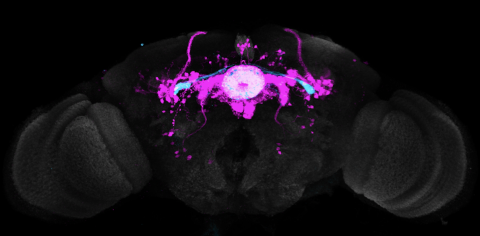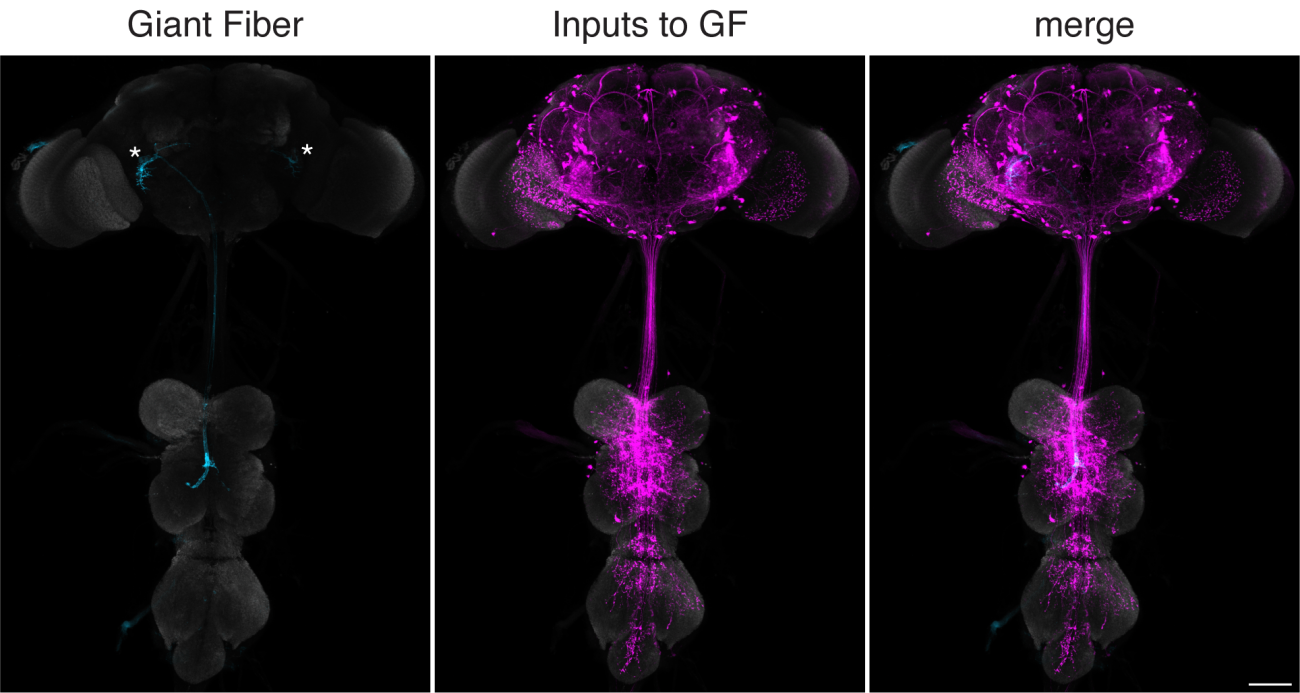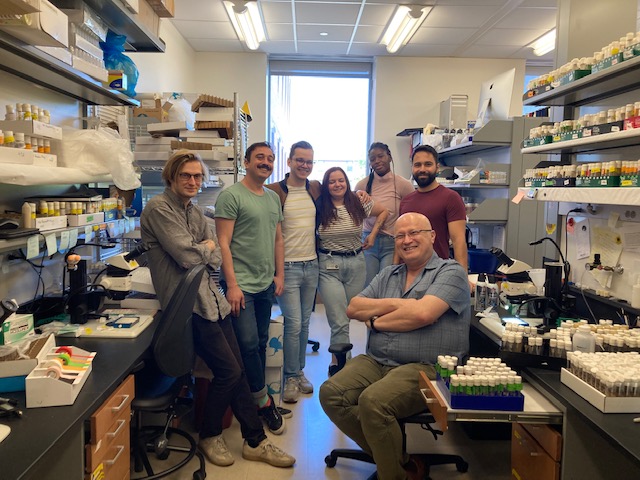
France. Japan. England. These are the locations of some of the scientists who started messaging Gilad Barnea on May 11, within hours of the publication of his lab’s new paper in eLife.
The scientists wanted Barnea to send them vials full of fruit flies the Barnea lab has genetically engineered to function for retrograde transsynaptic circuit tracing. The lab has named the tool retro-Tango. “retro” indicates that the tool does the tracing in the retrograde direction, against the flow of information between neurons in a circuit. “Tango” stems from the nature of the molecular switch at the core of the tool, which consists of two parts and is a reference to “It takes two to tango.”
“A neural circuit consists of populations of neurons that are connected via synapses and serve a particular function. Every aspect of the nervous system in health and disease has a manifestation, and sometimes cause, at the level of the circuit. Therefore, a tool that allows you to look at the circuit level is extremely useful and a dire need for neuroscientists,” explained Barnea.

Specifically, retro-Tango enables researchers to identify the neurons serving as inputs of information to specific neurons of interest within a circuit. For example, scientists and non-scientists alike have long been curious about the fly’s ability to quickly escape an approaching object (think: fly swatter). This ability is mediated by the giant fiber circuit, and retro-Tango can be used to reveal the visual inputs onto the giant fiber that elicit this response. The result is a microscope image in which these visual inputs are lit in bright magenta, while the giant fibers are in cyan.
The design of retro-Tango is modular, and therefore, it allows researchers to not only reveal the inputs to the neurons of interest, but also to visualize the activity of these inputs and even to manipulate them.
What’s more, using retro-Tango does not rely on a prior hypothesis, so scientists are able to use the tool as a starting point to explore and develop potential theories. Previous to this discovery, an unbiased, user-friendly, and flexible tool for circuit tracing in the retrograde direction did not exist. In their report on the paper, the eLife editorial team stated, “the significance of this contribution [is] important and for some applications fundamental.”
Barnea and his lab are used to their flies being a hot commodity. In 2017 they developed trans-Tango, a tool which performs anterograde transsynaptic tracing, mapping neural circuitry in the direction of information flow. Since then, trans-Tango has been implemented in more than 200 scientific papers, helping to reveal neuronal connectivity in the olfactory, gustatory and visual circuits of flies, as well as circuits involved in their circadian behaviors, courtship, navigation, motor control and many more.
Barnea has been “obsessed” with creating such a tool for trans-synaptic tracing and manipulation of neurons within a circuit ever since he was a postdoctoral fellow. Developing trans-Tango took him and his team two decades. After getting that far, he thought re-working the principles of the trans-Tango tool to do the opposite direction would be easy. It wasn’t.
“It's different than when you do research on a particular biological problem,” Barnea said. “If you study a biological system and you do the right experiments, you will get an answer. Here, if you get it to work, you have a wonderful tool. Everybody will use it. But if it fails, then you have nothing because you didn’t uncover any mysteries of nature.”
Altar Sorkaç, a postdoctoral research associate in the Barnea lab and the new paper’s first author, has been involved in the more than six-year process of developing retro-Tango. Essential to understanding how this new tool works, he explained, is the concept of signal to noise. In order to clearly see a signal (in magenta), there needs to only be minimal noise (magenta in irrelevant places that would muddy the picture). When the team initially tried to reverse trans-Tango, they didn’t get any noise, but there wasn’t any signal either.
At this point, Barnea opined, another lab might have scrapped the project. The sheer amount of trial and error, supplies, equipment and staff hours–all without a guarantee of success–would have steered many researchers away or just proved financially untenable for some. But Sorkaç, a postdoctoral research associate from Turkey whose graduate training at Brown was underwritten by the Suna and Inan Kıraç Foundation, had the experience of being a member of the team that developed trans-Tango under his belt. He knew which variables they had tried in the past, so he simply tried them all again, testing tens of combinations of different components.
“Whenever you ask yourself whether you should try this or that,” Barnea said, “the answer is almost always both.”
The Tango design, which is the basis for both trans-Tango and retro-Tango, relies on a Frankensteinian mix of proteins. To solve the problem of not observing any signal, Sorkaç switched out the various proteins until he found a combination that yielded any signal. From there, he optimized the tool by trying other variables in order to reduce the noise and create the clearest signal.
Another change from the trans-Tango formula that proved key was the temperature in which the lab raised the flies. trans-Tango flies are raised at 18°C. But Sorkaç and the team found that in fact, raising flies at 25°C was the thing that did the trick for retro-Tango.

In addition to the excitement of the discovery itself, this is the first publication of three graduate students: Rareș Moșneanu, Angel Okoro and Ezgi Memiş. Memiş and another author of the paper, Doruk Savaş, like Sorkaç and another former student, Mustafa Talay, before them, are supported by the Kıraç Foundation, an organization dedicated to the cultivation of empowered citizens that will contribute to Turkey and its people. Savaş, a graduate student in the lab, is also a recipient of a recent Carney Graduate Award in Brain Science.
Awards like these, Barnea said, together with the Zimmerman Innovation Awards in Brain Science the lab received during their development of trans-Tango, are what provide the Barnea lab with the people-power, supplies, and equipment necessary to perform this type of high-risk, high-reward research.
Even the opening of the paper itself bears the lab’s signature stamp of creativity, innovation, and willingness to try anything. When Sorkaç sat down to begin writing, the first words that came into his head were those of the Turkish poet Nazım Hikmet. Sorkaç translated the lines of the poem into English himself and used them to begin the paper: “To live, like a tree one and free/And like a forest, sisterly.”
“The idea is that yes, neurons are individual units, and you can study them, but another important aspect of the nervous system is to study the whole, or the circuits, because they are in coordination with each other. They manipulate each other. They change each others’ activities,” Sorkaç explained.
It was an unorthodox choice, and Sorkaç worried what kind of a reception it would get from his mentor. Nevertheless, he passed the draft along to Barnea.
Barnea loved it.